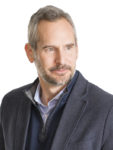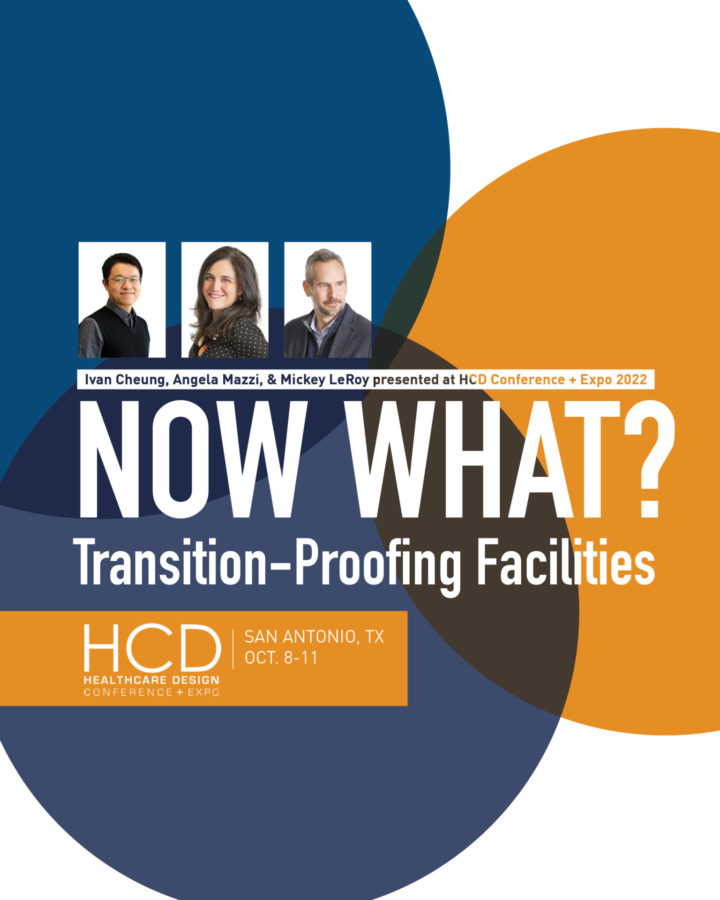Insights
Dec 19, 2022 _ insights
Now What? Transition-Proofing Facilities Plans
If you work in healthcare facilities long enough, you’ll inevitably experience a major disruption during a design/construction project. Maybe there is a leadership transition or a significant scope or budget change. Whatever drives the change, it can leave the project team—client and designer—scrambling to adapt the design to new conditions.
We recently shared some thoughts on how to manage those transitions at the 2022 Healthcare Design Conference + Expo. In what follows, we’ll provide an overview. Feel free to review our presentation and reach out for more information:
- Shifting to a Model of Co-Creation. Different organizations favor different approaches to decision-making. Some favor top-down, leadership-driven approaches. Others prefer bottom-up, user-centered approaches. Over the years, we’ve come to recognize the value of both. The bottom-up approach allows you to tap into existing knowledge about an organization’s culture, what’s working, and what’s not. But it also tends to be resistant to innovation, favoring the known over the unknown. Leadership-driven approaches can help overcome that limitation, providing valuable strategic direction, but it’s equally critical to understand details of process and culture provided by department staff. Instead of favoring one approach over another, we think it’s important to move towards a model of co-creation, where people throughout the organization provide meaningful feedback without losing sight of strategic priorities.
- Types of Change. The design process can be lengthy and subject to many kinds of transitions. Sometimes a change in leadership team leads to a change in strategy. Sometimes it’s a change in technology, market conditions, or research. These fall roughly into three types. There are changes in strategy, scale, and expertise.
- Managing Transitions. Whatever drives a change, it is easier to manage it—and focus on the most relevant elements of the design—if you have segmented the design into modules (or discrete elements that can be examined independently). If the design provides clear hierarchy that helps identify its core components and those that can be easily adapted, it can help focus your efforts when revisiting the design concept. This provides a shared matrix that a team can rely on when a design change is necessitated.
Even when a design process proceeds smoothly from beginning to end without any major changes, it is helpful to think about these concepts in this way, because it will contribute to the larger organizations’ process of understanding, providing feedback, and signing onto the design strategy.
To learn more about how to manage changes to your design process, visit our presentation here.
 Ivan Cheung, AIA is a principal at GBBN. While helping lead the firm’s design mentorship program, Ivan works in all markets and project types, including the Andrew J Brady ICON Music Center, the award-winning Lake West Five Exhibition Hall, Beijing’s Zoo Tower, and a clinical prototype for Bon Secours Mercy Health that will be built across the Southeastern US.
Ivan Cheung, AIA is a principal at GBBN. While helping lead the firm’s design mentorship program, Ivan works in all markets and project types, including the Andrew J Brady ICON Music Center, the award-winning Lake West Five Exhibition Hall, Beijing’s Zoo Tower, and a clinical prototype for Bon Secours Mercy Health that will be built across the Southeastern US.
 Mickey LeRoy, AIA, ACHA, LEED AP is a principal at GBBN. He leads teams in all phases of planning, design, and delivery of multi-faceted healthcare projects like TriHealth’s Thomas Center. He works closely with leading healthcare systems, like Bon Secours Mercy Health, to develop efficient clinical prototypes that can work with different building scales. With previous experience in public relations and marketing, Mickey’s communication skills complement his abilities in design and project management.
Mickey LeRoy, AIA, ACHA, LEED AP is a principal at GBBN. He leads teams in all phases of planning, design, and delivery of multi-faceted healthcare projects like TriHealth’s Thomas Center. He works closely with leading healthcare systems, like Bon Secours Mercy Health, to develop efficient clinical prototypes that can work with different building scales. With previous experience in public relations and marketing, Mickey’s communication skills complement his abilities in design and project management.
 Angela Mazzi FAIA, FACHA, EDAC is a principal at GBBN. Harnessing studies on human psychology, research on our biological need for nature, a focus on clinical workspaces, and experience with Lean strategies, Angela creates exceptional environments that empower patients and practitioners. She regularly presents and publishes her research in industry and peer reviewed journals and is sought out by Healthcare Design Magazine, the New York Times, and other publications to share her healthcare expertise with their readers.
Angela Mazzi FAIA, FACHA, EDAC is a principal at GBBN. Harnessing studies on human psychology, research on our biological need for nature, a focus on clinical workspaces, and experience with Lean strategies, Angela creates exceptional environments that empower patients and practitioners. She regularly presents and publishes her research in industry and peer reviewed journals and is sought out by Healthcare Design Magazine, the New York Times, and other publications to share her healthcare expertise with their readers.




